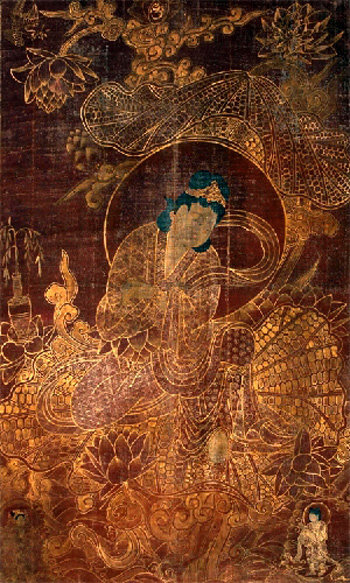Painting of Buddhist Goddess of Mercy from 16th century found
Painting of Buddhist Goddess of Mercy from 16th century found
Posted November. 27, 2015 11:08,

Avalokitesvara Bodhisattva (the Buddhist Goddess of Mercy) is sitting cross-legged on a lotus with a virtuous and gentle impression. Her merciful eyes are laid on Sudhana putting his hands together. As described in the Avatamska Sutra, she seems proud of him for seeking after the Buddhist laws from 53 priests of high virtue. While the goddess is preaching to the young monk, Karttikeya of sturdy build is guarding her. A golden lotus blooming from the water and a bird in the sky with a flower in its beak add more mystiques to the picture.
This painting of Avalokitesvara Bodhisattva, which has recently been found in Japan, is believed to have been drawn in Korea in the mid 16th century during the Joseon Dynasty. There are four paintings of Avalokitesvara Bodhisattva drawn during the dynasty that have been found so far. This recently found painting is the only one among the four that portrays her with legs crossed. Avalokitesvara Bodhisattva in paintings drawn during the Goryeo Dynasty typically bends one leg and lowers the other. In paintings drawn during the Joseon Dynasty, the Goddess lifts one knee forward and puts one hand on it.
"Recently, a very unique painting of Avalokitesvara Bodhisattva was found in a temple in Kamakura, Kanagawa Prefecture, Japan," says Dongguk University Museum Director Jeong Woo-take, an expert on Buddhist paintings. "Based on techniques used to draw her ample face, clear outline, and gradation of the lotus, I assume the painting was drawn in the mid 16th century." According to Chung, there are six to seven woodprints that are similar to this painting, including those in Guin Temple, but such a painting had never been found.
This newly found painting was drawn on a 119.2 cm x 70.9 cm hemp cloth. The painting has typical characteristics of Buddhist paintings; a red background and a golden outline drawn carefully. Chung evaluates the painting by saying, "This paining is a representative example of Korean reinterpretation of Chinese paintings. It adds to the variety of Buddhist paintings drawn in the early Joseon Dynasty."
Chung will present a paper, titled "Painting of Avalokitesvara Bodhisattva, the New Drawing Techniques in the Early Joseon Dynasty," in the Dongak Art History Association conference held in Dongguk University on Saturday.
sukim@donga.com







